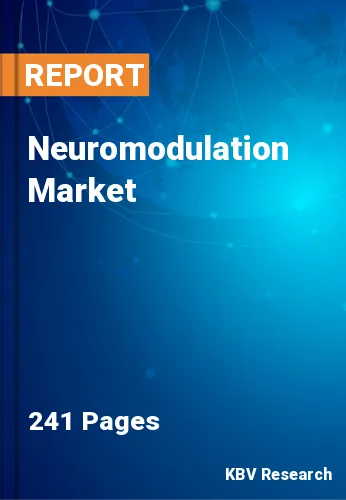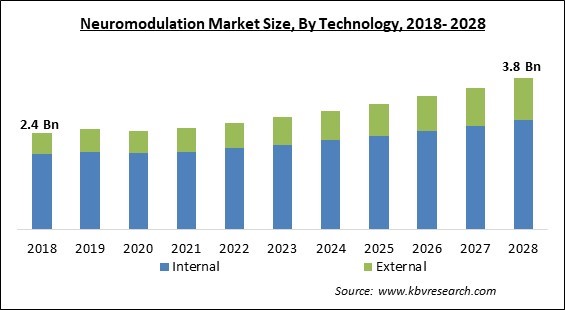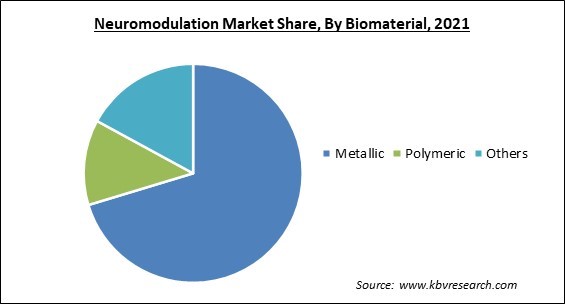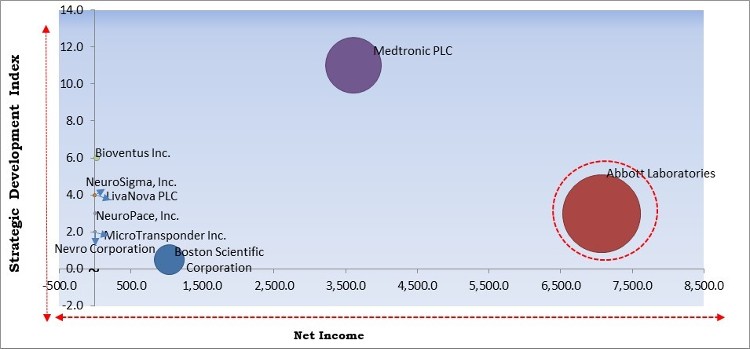
The Global Neuromodulation Market size is expected to reach $3.8 billion by 2028, rising at a Market growth of 6.0% CAGR during the forecast period.
Neuromodulators are a type of neurotransmitter that is a subgroup of neurotransmitters. Neuromodulators, unlike neurotransmitters, are released in a diffused way. This indicates that exposure to the neuromodulator could expose a complete neural tissue to its effects. As a result, the neuronal circuitry of an entire brain region, rather than simply a single neuron, may be tuned.
The growing incidence of various types of neurological illnesses, such as Alzheimer's disease, dementia, stroke, and brain tumors, is driving the expansion of the neuromodulation Market. The increase in the prevalence of brain illnesses and the use of neuromodulation devices in developed nations are both contributing to the expansion of the neuromodulation Market share. Deep brain stimulation (DBS) is a technique for treating epilepsy and Parkinson's disease. The Market for neuromodulation is growing as the prevalence of epilepsy rises. Epilepsy, for example, is a chronic non-communicable brain disorder that affects people of all ages, according to the World Health Organization (WHO) in February 2022. According to the same source, around 50 million people across the world have been diagnosed with epilepsy.
Furthermore, the increase in the geriatric population aided the Market 's expansion. Alzheimer's along with other neurological disorders are more common in the elderly population. According to the Alzheimer's Association, a non-profit organization, approximately 6.2 million Americans aged 65 and older were diagnosed with Alzheimer's dementia in 2021.

Since most hospitals are closed owing to continuous lockdowns in numerous countries, the COVID-19 pandemic has had a negative effect on the neuromodulation Market 's growth. COVID-19's spread resulted in severe public health concerns. However, a large number of clinics and hospitals around the world have been reformed in order to improve hospital capacity and deliver better healthcare. In addition, neuromodulation sales have decreased across multiple regions due to a fall in both new patient and service implant procedures. Plenty of people who otherwise would have gotten tested for their mental illnesses has had to avoid visiting hospitals because of the risk of the infection. In most countries around the world, only patients with severe conditions were allowed to visit hospitals since the hospital beds were all occupied by severely afflicted COVID-19 patients.
Deep brain stimulation (DBS) uses electrodes coupled to a pulse generator implanted in the patient's body to continuously administer low bipolar or monopolar electric impulses, activating a tiny portion of the brain. DBS is used to treat pain, epilepsy, movement disorders like tremors, Parkinson's disease, dystonia, and psychiatric disorders like Tourette syndrome, obsessive-compulsive disorder, and depression, among others. Manufacturers are now working to improve their existing DBS systems while also designing the next generation of devices. DBS is being targeted to different parts of the brain by researchers, who are testing the treatment on distinct groups of Parkinson's patients.
A considerable number of the patient population suffering from chronic illnesses such as chronic back pain, depression, epilepsy, and sleep apnea, among others, is displaying medication and drug resistance. Resistance manifests itself in the form of slow treatment progression and delayed or limited effects. As a result, healthcare professionals are focusing more on neurostimulation techniques for the treatment of chronic illnesses, which is propelling the neuromodulation devices Market forward. Epilepsy, treatment-resistant depression, and other chronic diseases impose a significant financial burden on countries in terms of patient treatment.
In developing countries, the prevalence of neurological diseases such as epilepsy, depression, and others is increasing at an incredible rate. Despite having a substantially larger frequency, emerging countries have lower diagnostic rates, which limits the number of individuals who require treatment. Lower diagnosis rates in these nations are attributed to a variety of causes, including a lack of public awareness and limited access to diagnostic facilities due to inadequate healthcare infrastructure. Low income is also one of the leading factors which forbid some people from visiting the hospital and getting tests done to arrive at the correct diagnosis.

Based on Technology, the Market is segmented into Internal and External. The internal segment acquired the largest revenue share in the neuromodulation Market in 2021. The significant demand for this technology is due to the growing incidence rate of the chronic leg, back, and arm pain, as well as the applicability of this technology in the effective management of these chronic pains. Due to an increase in the incidence of Parkinson's disease and an increase in product approval for neurological disease treatment, the internal modulation technology would be in demand in the upcoming years.
Based on Biomaterial, the Market is segmented into Metallic, Polymeric, and Ceramic. The polymeric segment procured a substantial revenue share in the neuromodulation Market in 2021. Polymeric biomaterials (biopolymers) are materials that can be employed for long or short periods of time in physiological conditions. Polymeric biomaterials cover the widest range of synthetic and hybrid materials now employed in medicine. This factor is increasing the growth of this segment of the neuromodulation Market .
Based on Application, the Market is segmented into Chronic Pain, Urinary & Fecal Incontinence, Migraine, Failed Back Syndrome, Parkinson Disease, Epilepsy, Tremor, Depression, and Others. The chronic pain segment acquired the largest revenue share in the neuromodulation Market in 2021. Due to an increase in the prevalence of chronic disease and increased R&D activity in the healthcare sector, the demand for neuromodulation in rapidly surging. In addition, the increasing adoption of sedentary lifestyle in people all over the world is one of the major factors that is increasing the instances of chronic pain in these people. This factor would play a major role in accelerating the growth of this segment.
| Report Attribute | Details |
|---|---|
| Market size value in 2021 | USD 2.6 Billion |
| Market size forecast in 2028 | USD 3.8 Billion |
| Base Year | 2021 |
| Historical Period | 2018 to 2020 |
| Forecast Period | 2022 to 2028 |
| Revenue Growth Rate | CAGR of 6% from 2022 to 2028 |
| Number of Pages | 241 |
| Number of Tables | 405 |
| Report coverage | Market Trends, Revenue Estimation and Forecast, Segmentation Analysis, Regional and Country Breakdown, Competitive Landscape, Companies Strategic Developments, Company Profiling |
| Segments covered | Technology, Biomaterial, Application, Region |
| Country scope | US, Canada, Mexico, Germany, UK, France, Russia, Spain, Italy, China, Japan, India, South Korea, Singapore, Malaysia, Brazil, Argentina, UAE, Saudi Arabia, South Africa, Nigeria |
| Growth Drivers |
|
| Restraints |
|
Based on Regions, the Market is segmented into North America, Europe, Asia Pacific, and Latin America, Middle East & Africa. North America acquired the largest revenue share in the neuromodulation Market in 2021. The significant growth of the regional Market is attributed to the rise in prevalence of neurological diseases, the presence of key players in the regional neuromodulation Market , and well-established infrastructure in the region. The presence of key Market players and large pharmaceutical and biopharmaceutical industries, as well as increased investments in the country for the adoption of innovative technologies, is likely to support the regional Market 's expansion.
Free Valuable Insights: Global Neuromodulation Market size to reach USD 3.8 Billion by 2028

The major strategies followed by the Market participants are Approvals and Trials. Based on the Analysis presented in the Cardinal matrix; Abbott Laboratories is the forerunners in the Neuromodulation Market . Companies such as MicroTransponder Inc., Boston Scientific Corporation are some of the key innovators in the Market .
The Market research report covers the analysis of key stake holders of the Market . Key companies profiled in the report include Medtronic PLC, LivaNova PLC, Boston Scientific Corporation, Abbott Laboratories, Nevro Corporation, NeuroSigma, Inc., NeuroPace, Inc., Neuronetics, Inc., MicroTransponder Inc., and Bioventus Inc.
By Technology
By Biomaterial
By Application
By Geography
The neuromodulation market size is projected to reach USD 3.8 billion by 2028.
Rising demand for deep brain stimulation are driving the market in coming years, however, low diagnosis and treatment rates in developing countries growth of the market.
Medtronic PLC, LivaNova PLC, Boston Scientific Corporation, Abbott Laboratories, Nevro Corporation, NeuroSigma, Inc., NeuroPace, Inc., Neuronetics, Inc., MicroTransponder Inc., and Bioventus Inc.
The Metallic segment acquired maximum revenue share in the Global Neuromodulation Market by Biomaterial in 2021; thereby, achieving a market value of $2.6 billion by 2028.
The North America is the fastest growing region in the Global Neuromodulation Market by Region in 2021.
Our team of dedicated experts can provide you with attractive expansion opportunities for your business.
